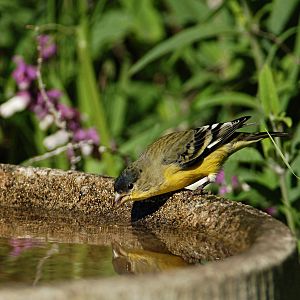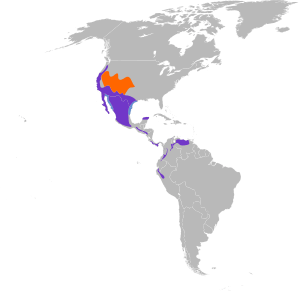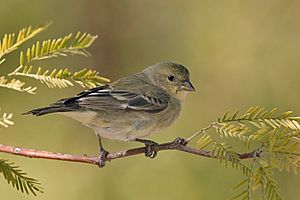Lesser goldfinch facts for kids
Quick facts for kids Lesser goldfinch |
|
|---|---|
 |
|
| Intermediate male; note mottled back and cap |
|
| Conservation status | |
| Scientific classification | |
| Subspecies | |
|
see text |
|
 |
|
| Synonyms | |
|
Fringilla psaltria (protonym) |
The lesser goldfinch (Spinus psaltria) is a very small songbird found across the Americas. It's part of a group of birds called American goldfinches. This group includes the American goldfinch and Lawrence's goldfinch. They all belong to the bird family Spinus.
Male American goldfinches have a black (sometimes green) forehead. This helps tell them apart from the European goldfinch, which has a red or yellow face. Lesser goldfinches in North America can look quite different from each other. There are five main types, or subspecies, of this bird.
Contents
About the Lesser Goldfinch Name
The lesser goldfinch was first officially described by an American scientist named Thomas Say in 1822. He gave it the scientific name Fringilla psaltria. The word psaltria comes from Ancient Greece and means "female harpist."
Today, the lesser goldfinch is placed in the Spinus group. This group was named in 1816 by a German naturalist, Carl Ludwig Koch.
Types of Lesser Goldfinches
There are five recognized subspecies (types) of the lesser goldfinch:
- Green-backed goldfinch (S. p. hesperophilus): Found in the western U.S. and northwestern Mexico.
- S. p. witti: Lives on the Tres Marías Islands off western Mexico.
- Arkansas goldfinch (S. p. psaltria): Found from the west-central U.S. to south-central Mexico.
- S. p. jouyi: Lives in southeastern Mexico and northwestern Belize.
- S. p. colombianus: Found from southern Mexico all the way to Peru and Venezuela.
What Lesser Goldfinches Look Like
This tiny bird is the smallest Spinus finch in North America. It might even be the smallest true finch in the world! Lesser goldfinches are about 9 to 12 cm (3.5 to 4.7 in) long. They weigh between 8 to 11.5 g (0.28 to 0.41 oz).
Birds from Mexico and further south tend to be a bit larger than those from the northwest. Also, male lesser goldfinches can have different amounts of black on their heads and backs. This is why there are different types, or forms, of the bird.

Male lesser goldfinches are easy to spot. They have bright yellow undersides and large white patches on their tails and wings. Their backs and heads can be solid black or a medium green color. The "Arkansas goldfinch" type, which is mostly dark, is common in many areas. The lighter "green-backed goldfinch" type is more common in the far western U.S. and northwestern Mexico.
In places like Colorado and New Mexico, you can find many different looking males. East of southwestern Texas and in most of Mexico, almost all males have black backs.
Female and young lesser goldfinches look a bit different. Their upper parts are usually grayish olive-green. Their undersides are yellowish, but younger birds might look more buff-colored. They have only a small white stripe on their wings and little or no white on their tails. You can tell them apart from other finches by their small size, lack of white or yellow on their upper bodies, and their dark gray bill.
Sounds and Flight
Like other goldfinches, the lesser goldfinch has a wavy flight pattern. As it flies, it often makes a harsh "chig chig chig" call. Another special call is a very high-pitched, long whistle. It might go up in pitch ("teeeyeee") or fall ("teeeyooo"). Their song is a long, cheerful warble or twitter. It often includes sounds that imitate other bird species.
Where Lesser Goldfinches Live
This American goldfinch lives from the southwestern United States (as far north as Washington) all the way south to Venezuela and Peru. Birds from the colder parts of the U.S. will migrate to warmer areas for winter.
Lesser goldfinches often gather in groups. They can be found in almost any place with trees or bushes, except for very dense forests. They are common in many areas and often come close to houses. In the Southwest United States, they are often seen at bird feeders, especially those with thistle socks. You might see groups of six or more birds at feeders.
They mostly eat tree buds and weed seeds. Sometimes, they have even been seen eating soil or clay, which is called geophagy.
Reproduction and Life Cycle
The nesting season for lesser goldfinches is in the summer in cooler regions. In warmer, tropical areas, they seem to breed all year round, though perhaps less often in September and October.
Females lay three or four bluish-white eggs. They build a cup-shaped nest using fine plant materials like lichens, rootlets, and strips of bark. The nest is usually placed in a bush or at a low to middle height in a tree.
The lesser goldfinch is considered a "Species of Least Concern" by the IUCN. This is because it lives across a very large area. However, its numbers seem to be decreasing in some local places.
Images for kids
See also
 In Spanish: Jilguero menor para niños
In Spanish: Jilguero menor para niños




